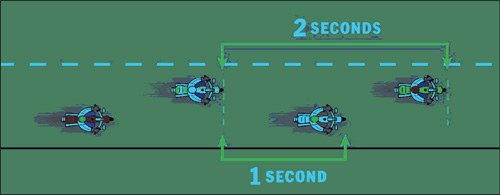2. This allows for sufficient stopping room, maneuvering room and line of sight thus improving safety.
3. This allows for the rest of the riders to clearly see the hand signals of the second rider and to pass them down along the formation.
Formation is especially important when trying to stay together. Anticipate your next move and those of the group. If a road hazard is observed, point to it as you pass so other riders can avoid the hazard. Such information should be passed down the line.
We always want to avoid two bikes riding side by side so the proper way to reform a staggered formation, should a gap occur, is to shift lane position from left to right or right to left but not to pass any rider to fill gap.
Following Distances. The distance a rider maintains between his bike and the bike in front must never be less than what is comfortable for the rider and the rider in front. Generally allow 2 or 3 seconds from the rider directly in front of you and 1 to 2 second from the rider in the next lane. No rider should ever ride closer than he/she feels comfortable with. Furthermore, if a rider feels that the following rider is too close, he/she is expected to inform the following rider who must respect the request to keep a greater distance. A hand signal of left arm down with palm facing the rear in a pushing action will be used to request a following rider to keep a greater distance. This request must be honored. However, a 5,10, 20 or 30 second interval presents its own dangers. Group riding means riding as a group.

The Human Chain. You are responsible for the rider behind you. When approaching a turn, be sure to check your side view to be sure the following bike can see you make the turn. Do not turn off the current road if you do not see the bike that is supposed to be behind you. The biker behind you will do the same and stop at the intersection to allow the following rider to catch up. This will allow you to make the turn without fear of losing the rest of the group.
|